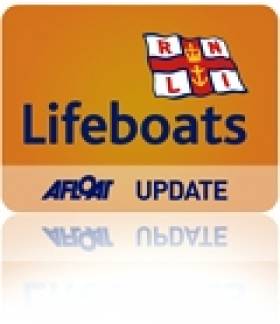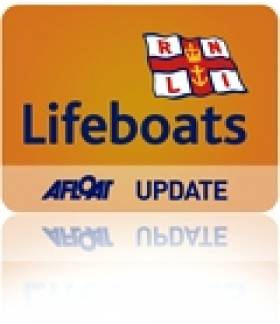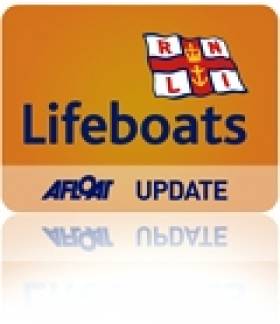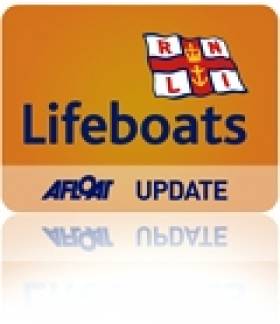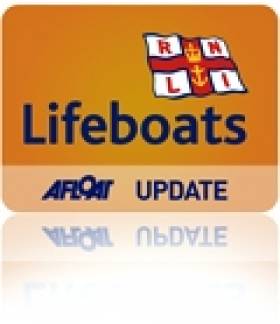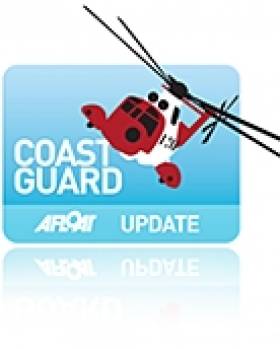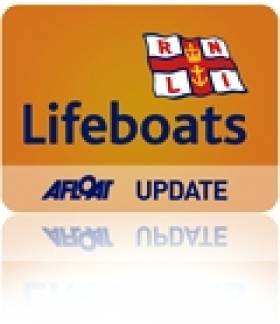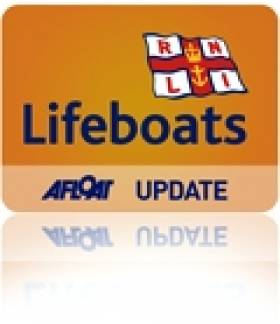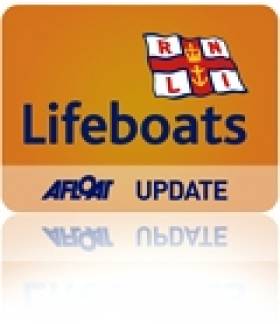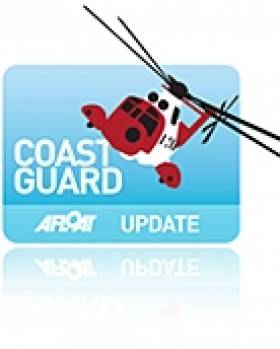Displaying items by tag: Lifeboats
Lifeboat Rescues Windsurfer In Stormy Conditions
#RNLI - Kilkeel RNLI rescued a windsurfer who got into difficulty in Carlingford, Co Louth yesterday (Tuesday 29 January).
The charity’s volunteer lifeboat crew was requested to launch by the Irish Coast Guard shortly after 2pm following a report that a windsurfer had got into difficulty in Carlingford Lough.
Launching their inshore lifeboat immediately, the crew encountered very unfavourable weather, with strong westerly winds of between force six and seven.
The lifeboat proceeded up the lough where they found and retrieved the windsurfer who had stayed by his board. The crew then attempted to retrieve the sail and board but couldn’t due to the windy weather conditions. They instead proceeded to tow the board into Greenore where the local coastguard took over.
Despite being in the water for approximately an hour, the casualty was described as being in reasonably good health.
Roy Teggarty, Kilkeel RNLI lifeboat operations manager, paid tribute to the lifeboat crew for their efforts in what was a challenging rescue:
"This was a day with difficult conditions because of the strong winds," he said. "It was mainly difficult to keep the lifeboat steady when retrieving the casualty so this rescue involved expert boat handling by all involved."
Lough Swilly RNLI Featured On 'Ear to the Ground'
#RNLI - RTÉ’s popular agricultural programme Ear to the Ground paid a visit to Lough Swilly RNLI recently which will feature on this week's episode on Thursday evening.
Set to feature is local man Francis Burns, who along with running a successful farm hoof care business also volunteers with Lough Swilly RNLI’s lifeboat crew.
The programme, which looks at issues concerning agriculture and the rural community, had planned to spend a day with Burns carrying out his job – but when producers heard about his role as a volunteer lifeboat crew member, they decided to include his role with the RNLI too.
Burns and fellow Lough Swilly lifeboat volunteers Eamonn Mahon, Michael Doherty, Tommy Cooper and Francis Bourne showed their guests around the station and demonstrated a lifeboat launch for them.
While most visitors to the station are particularly interested in the RNLI’s Atlantic 85 inshore lifeboat, the Ear to the Ground crew were particularly impressed with the RNLI’s huge custom-built tractor, which the lifeboat crew uses to launch and recover the lifeboat.
The massive tyres are filled with water and antifreeze to make sure it stays on the ground when it enters the water.
Speaking about the filming, Burns said: “I’ve wanted to be a member of Lough Swilly RNLI ever since we got a day off school to come down and see the new all-weather lifeboat arriving at the station.
"Lifeboats are in my family as my cousin George O’Hagan is also the second coxswain on the lifeboat.
"It will be great to be able to show people how lifeboat volunteers can work in the agricultural sector and still be able to train and go out on the lifeboats to help rescue people.”
Programme director Liam Lavelle added: “We are delighted to be able to include the RNLI on Ear to the Ground. It’s a great story about people who volunteer to save lives.
"In our programme we try and reflect what people are doing in rural communities. Many of these communities touch the sea and this work is an important part of Francis’s story."
The programme is due to air on RTÉ One this Thursday evening 31 January at 8.30pm.
RNLI Answers More Than 400 Calls in NI in 2012
#RNLI - Lifeboats in Northern Ireland launched 255 times to a variety of call-outs in 2012 in a year that saw the institution's lifeboats and lifeguards answer 413 calls for help.
RNLI search and rescue operations saw 236 people brought safely to shore throughout the year by the nine volunteer lifeboat crews located across the region.
The annual statistics released by the charity today (22 January) show that of the figures, 111 services took place in darkness while crews collectively spent 2,193 service hours at sea.
Bangor was the busiest lifeboat station in Northern Ireland last year, launching to 53 requests for help with the crew rescuing 53 people off the Co Down coast.
Enniskillen, which operates two bases on Upper and Lower Lough Erne in Co Fermanagh and which is the North’s only inland RNLI station, launched 46 times and brought 50 people to safety.
Meanwhile, Portrush RNLI in Co Antrim launched 33 times and rescued 33 people.
It was also a busy year for the 10 RNLI lifeguard units located on beaches in Co Down and along the Causeway Coast, where lifeguards responded to 158 incidents and assisted 176 people who found themselves in difficulty.
The Causeway Coast, where there are seven units located, was the busiest area, with Portrush East lifeguards responding to 31 incidents and assisting 35 people. The Benone unit attended 30 incidents and assisted 30 people while the Portrush West unit responded to 25 incidents and assisted 32 people.
Overall in Ireland, RNLI lifeboats launched 939 times with the volunteer crews across the 44 stations rescuing 1,041 people. Dun Laoghaire was the busiest lifeboat station in the Republic in 2012, responding to 46 call-outs throughout the year and rescuing 76 people.
Commenting on the 2012 statistics for Northern Ireland, RNLI operations manager Martyn Smith said: "The RNLI lifeguard service has expanded to 10 beaches in Northern Ireland and with the support of the local authorities they have an active and welcome presence on many beaches.
"They do not just saves lives and assist those in trouble in the sea, but also provide information, advice and first aid when needed, ensuring many potential incidents are prevented.
"I would like to say a huge thank-you to all those who support the RNLI, a charity dependent on the generosity of the public, whether by giving up their time or by making a donation."
Lifeboat Crews Tow Vessel From Rocks Off Waterford
#Lifeboats - TheJournal.ie reports that RNLI lifeboat crews from Dunmore East and Fethard rescued two fishermen from their vessel off the Waterford coast yesterday (14 January 2013).
Rescuers sped to the scene after the 10-metre fishing boat got into difficulty and grounded close to the shore north of Loftus Hall.
Despite the receding tide, the lifeboats managed to tow the vessel carefully off the rocks "without any major damage", according to a spokesperson. The two crew were uninjured in the incident.
It marked the third major call-out in a week off the Waterford coast - following a similar rescue effort last Tuesday, and just days after the tragic loss of a local fisherman on Thursday morning on the sixth anniversary of the sinking of Dunmore East trawler the Pere Charles.
Meanwhile, on Sunday afternoon volunteers with Achill Island RNLI went to the assistance of an injured fisherman off the Mayo coast.
The lifeboat station received the distress call around noon to go to the assistance of a fishing party north of Clare Island, where the crew removed a man from the vessel who had suffered an eye injury from a fishing hook.
He was subsequently transported on the lifeboat to Kildavnet, where a local doctor examined his injury before referring him to Castlebar General Hospital for further attention.
Suspected Engine Fire Leads to Yacht Rescue off Dun Laoghaire
#RNLI – Lifeboats at Dun Laoghaire were called out yesterday following a distress call from a yacht with a suspected fire on board.
The incident took place shortly after mid-day while a second call for a kitesurfer in difficulty was received soon afterwards.
The yacht had been on a sail-training trip with a skipper and six crew on board when a high-temperature alarm and smoke alerted the crew. Fire extinguishers were used on the engine compartment and the skipper notified the Irish Coast Guard's Marine Rescue Co-Ordination Centre in Dublin (MRCC Dublin).
The RNLI All-Weather lifeboat (ALB) and Inshore lifeboat (ILB) launched immediately and were quickly on scene in the harbour where the yacht had moored. The coastguard rescue helicopter from Dublin Airport and the Irish Lights vessel Granuaile also responded to the alert.
The lifeboat took the six crew-members off the 37-foot yacht while two RNLI crew-members boarded the casualty vessel to inspect for damage with the skipper. An over-heating engine was the suspected cause and the vessel was taken in tow to Dun Laoghaire marina where all crew members were brought ashore. Units of the Dublin Fire Brigade attended at the marina and checked the vessel. Nobody was injured in the incident.
Meanwhile, the ILB was diverted from the call to the sail-training yacht to a kitesurfer in difficulty off the South Bull Wall. The coastguard helicopter proceeded to the scene and spotted the casualty who had become separated from his board.
Although weather conditions were fine, a fresh Easterly breeze against the ebbing Spring tide had caused a moderate seaway and swell while the casualty was attempting the swim for shore. The ILB crew recovered the casualty and landed him at the beach beside the Pigeon House at Ringsend where he did not require medical attention.
Two Dead In Separate Incidents At Sea On Thursday
#Coastguard - The Irish Times reports on the death of a local fisherman off the Waterford coast on Thursday morning in an incident that prompted a major coastguard and lifeboat search and rescue operation - six years to the day after the tragic sinking of Dunmore East trawler the Pere Charles.
The Irish Coast Guard's Rescue 117 helicopter was dispatched to before 8am along with the RNLI lifeboats from Dunmore East and Tramore to the scene off Brownstown Head after a 16-foot fishing boat capsized, throwing its two-man crew into the water.
James Tate reached the shore unaided after some two hours in the water to raise the alarm. He was later treated for shock and hypothermia.
His friend Johnny Flynn - a former member of the Dunmore East lifeboat crew, according to the Irish Independent - was found unconscious in the water by the coastguard helicopter before 8.30am, but efforts to resuscitate him were unsuccessful.
The men's boat has been recovered, and a spokesperson for the Marine Casualty Investigation Board confirmed that a full investigation and inquest into Flynn's death would take place.
The incident came just two days after four fishermen were rescued from their boat off Hook Head in Co Waterford.
Elsewhere, it's reported that a Spanish fisherman died after sustaining head injuries on a trawler off Loop Head in Co Clare on Thursday morning.
The Irish Times has more on both stories HERE.
Sea Trials Won't Weather New Shannon Class Lifeboat
#Lifeboats - The video above shows off a prototype of the RNLI's new lifeboat class, the Shannon, as it undergoes sea trials to determine how it handles the rough weather all too common to the seas around the UK and Ireland.
As previously reported on Afloat.ie, Irish naval architect Peter Eyre has been instrumental in the new lifeboat design, which is nearly 50% faster than the vessels currently in service.
It's also the second RNLI boat to be designed by an Irishman, after the Atlantic 21 developed in the 1970s by Cork-born Rear Admiral Desmond Hoare at the Atlantic College in Wales.
In other RNLI news, tributes were paid in the Isle of Man this week to the founder of the lifeboat institution in an annual ceremony on the Irish Sea island.
As BBC News reports, Sir William Hillary launched an appeal in 1824 that let to the formation of the RNLI, and he went on to serve as a member of the lifeboat crew at Douglas.
Lough Ree Locals Praise New RNLI Lifeboat Station
#Lifeboats - RTÉ News has a video report on a memorial to lives lost on the Shannon recently installed at the location of Lough Ree's new lifeboat station.
Relatives of those lost to the waterway spoke of their appreciation for the setting up of the new search and rescue base for the mid-Shannon after a decade of campaigning.
As reported on Afloat.ie last July, the RNLI's 44th lifeboat station in Ireland - located at Coosan Point in Athlone - Co Westmeath, has been welcomed as a search and rescue asset on Lough Ree and the Shannon.
Some €150,000 has been invested in the temporary facilities, from which volunteers operate the B class Atlantic 75 lifeboat Dorothy Mary, on a year-long trial basis.
According to RNLI Lough Ree's Matt Harte, the new station was among the busiest in Ireland last year, with up to 20 call-outs in its six months of operation thus far.
Sligo Sea Shanty Festival Returns For Fourth Year
#MaritimeFestivals - Running for the last three years, Sligo Bay RNLI is once again preparing for the Sea Shanty Festival in Rosses Point later this summer, with all proceeds going to the lifeboat station.
"The festival is a celebration of the long maritime tradition of Rosses Point and the Sligo area," as festival committee chair Willie Murphy explained last year.
"Shanties were working songs used on board sailing ships. The songs were mostly sung when the job involved several crew members working in rhythm together."
One of the many groups that have performed in the past is The Drunken Sailors from Germany, who have written a song inviting people back to Sligo Bay for the 2013 festival from 14-16 June.
The group’s story goes that back in the summer of 2012, the Drunken Sailor Shantymen were infected by the ‘Sligo Bay Virus’, and they asked their witch-doctor what medicine would help.
"You were infected by a well-known serious music virus out of the north-west of Ireland," they were told. "And the only think what may help, is to sing a song which tells a story of Sligo Bay.
"But take the medicine without any alcohol or other drugs, sing a great song for all friends of shanty music and you will get better!"
With this advice, the brave Drunken Sailor Shantymen started to sing the song you can hear in the video above, and which they think may move all famous artists to come back to Rosses Point Sea Shanty Festival later this year.
161 Lives Saved by Irish Coast Guard in 2012
#Coastguard - The Irish Times reports that the Irish Coast Guard saved 161 lives since January this year.
It was also the busiest year on record or the coastguard search and rescue service, with 1,963 call-outs in the past 12 months, an 8% increase on the previous year.
Minister for Transport Leo Varakdar was due in Howth this afternoon to pay tribute to staff and volunteers with both the Irish Coast Guard and RNLI lifeboats for their invaluable work.
“Without these volunteers, it simply wouldn’t be possible to provide the same level of emergency response," he commented.
In more sobering statistics, 88 bodies were recovered from the water in 2012, which is the highest annual number ever recorded.
And hoax calls were also on the up, with an "unacceptably high" 325 of such calls logged since January.
The Irish Times has more on the story HERE.


























